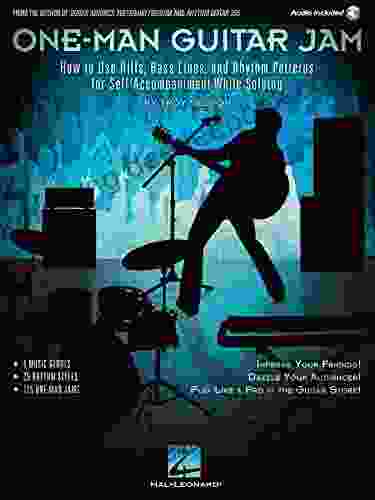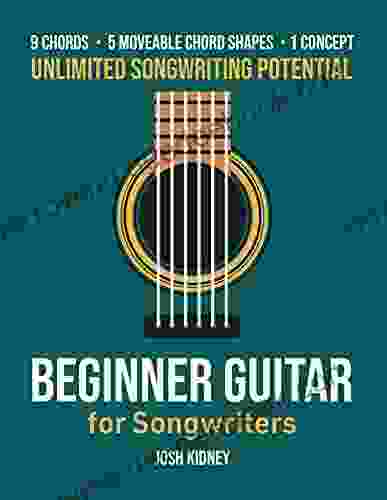How to Use Riffs, Bass Lines, and Rhythm Patterns for Self-Accompaniment While Singing and Playing Guitar

Self-accompaniment on guitar while singing is a versatile and fulfilling skill that enhances a musician's performance capabilities. By incorporating riffs, bass lines, and rhythm patterns, you can create a rich and engaging musical backdrop that supports your vocals and captivates your audience.
4.2 out of 5
| Language | : | English |
| File size | : | 177470 KB |
| Text-to-Speech | : | Enabled |
| Screen Reader | : | Supported |
| Print length | : | 248 pages |
| X-Ray for textbooks | : | Enabled |
| Paperback | : | 392 pages |
| Item Weight | : | 1.76 pounds |
| Dimensions | : | 7.6 x 0.91 x 10.28 inches |
Riffs
Riffs are short, repetitive melodic phrases that provide a foundation for your accompaniment. They add texture and interest to your performance and serve as a canvas for your improvisations.
Types of Riffs
- Power chords: These consist of the root, fifth, and octave intervals of a chord and convey a powerful, driving sound.
- Arpeggios: These are broken chords that can create a shimmering, melodic texture.
- Scales: Riffs based on scales provide a fluid and expressive foundation.
- Melodic riffs: These are short, memorable melodies that can add a catchy hook to your accompaniment.
Creating Riffs
- Listen to other guitarists: Analyze the riffs used by your favorite artists to identify patterns and techniques.
- Experiment with different voicings: Move the notes of a chord up or down the neck to create different timbres.
- Use open strings: Incorporating open strings can add resonance and a sense of space to your riffs.
- Practice improvisation: Jam over a simple chord progression and let your fingers guide you to create melodies.
Bass Lines
Bass lines provide the rhythmic and harmonic foundation of your accompaniment. They establish the groove and help drive the song forward.
Types of Bass Lines
- Root notes: These follow the root notes of the chords, providing a solid harmonic base.
- Walking bass lines: These are melodic bass lines that move stepwise, adding movement and interest.
- Syncopated bass lines: These emphasize off-beats, creating a rhythmic drive.
- Slap bass lines: These involve slapping and popping the strings to create a funky, percussive sound.
Creating Bass Lines
- Use root notes: Start by playing the root notes of the chords to create a steady foundation.
- Add syncopations: Experiment with playing bass notes on off-beats to add rhythmic interest.
- Explore different voicings: Play bass notes higher or lower on the neck to create different timbres.
- Practice with a metronome: Ensure your bass lines are rhythmically accurate by practicing with a metronome.
Rhythm Patterns
Rhythm patterns provide the rhythmic framework for your accompaniment. They add groove and momentum to your performance.
Types of Rhythm Patterns
- Straight eighth notes: These are evenly spaced eighth notes that create a steady, driving groove.
- Swing eighth notes: These are eighth notes that have a slight delay on the second beat, creating a relaxed, jazzy feel.
- Shuffle: This is a rhythm pattern where the second and fourth beats are accentuated, creating a bouncy groove.
- Bossa nova: This rhythm pattern features a syncopated bass line and a melody with dotted rhythms, creating a laid-back, Brazilian vibe.
Creating Rhythm Patterns
- Start with a simple pattern: Choose a basic rhythm pattern that you can easily play and sing along with.
- Experiment with different feels: Try playing the pattern with different rhythmic variations, such as syncopations or accents.
- Use a drum machine or backing track: These can provide a consistent rhythm to accompany your playing and singing.
- Practice regularly: The key to developing solid rhythm patterns is consistent practice.
Combining Riffs, Bass Lines, and Rhythm Patterns
Once you have mastered each element individually, the next step is to combine them to create a cohesive accompaniment.
Tips for Combining Elements
- Start with a simple riff: Choose a riff that is easy to play and complements your vocal melody.
- Add a bass line: Create a bass line that follows the root notes of the chord progression or adds rhythmic interest.
- Develop a rhythm pattern: Choose a rhythm pattern that complements the riff and bass line and sets the groove for your performance.
- Practice the combination: Rehearse the riff, bass line, and rhythm pattern together regularly to improve your coordination and timing.
Benefits of Self-Accompaniment
Self-accompaniment on guitar while singing offers numerous benefits for musicians:
- Increased musicality: Playing multiple roles forces you to develop your musicality, coordination, and timing.
- Improved vocal performance: Accompanying your singing can enhance your vocal control and projection.
- Greater versatility: Being able to self-accompany allows you to perform in a wider variety of settings and with greater flexibility.
- Enhanced songwriting: Self-accompaniment can inspire creative ideas and help you develop your songwriting skills.
- Increased confidence: Performing as a solo act can build your confidence and stage presence.
Learning how to use riffs, bass lines, and rhythm patterns for self-accompaniment while singing and playing guitar is a rewarding endeavor that can elevate your musical abilities and performances.
By following the techniques outlined in this article, you can develop your own unique style and create engaging and captivating self-accompanied performances.
4.2 out of 5
| Language | : | English |
| File size | : | 177470 KB |
| Text-to-Speech | : | Enabled |
| Screen Reader | : | Supported |
| Print length | : | 248 pages |
| X-Ray for textbooks | : | Enabled |
| Paperback | : | 392 pages |
| Item Weight | : | 1.76 pounds |
| Dimensions | : | 7.6 x 0.91 x 10.28 inches |
Do you want to contribute by writing guest posts on this blog?
Please contact us and send us a resume of previous articles that you have written.
 Book
Book Novel
Novel Text
Text Story
Story Genre
Genre Paperback
Paperback E-book
E-book Magazine
Magazine Newspaper
Newspaper Paragraph
Paragraph Bookmark
Bookmark Preface
Preface Synopsis
Synopsis Scroll
Scroll Classics
Classics Library card
Library card Narrative
Narrative Autobiography
Autobiography Encyclopedia
Encyclopedia Dictionary
Dictionary Thesaurus
Thesaurus Character
Character Resolution
Resolution Catalog
Catalog Study
Study Lending
Lending Reserve
Reserve Academic
Academic Journals
Journals Reading Room
Reading Room Rare Books
Rare Books Special Collections
Special Collections Interlibrary
Interlibrary Study Group
Study Group Thesis
Thesis Dissertation
Dissertation Storytelling
Storytelling Awards
Awards Book Club
Book Club Theory
Theory Kevin Bruyneel
Kevin Bruyneel Tracey Meredith
Tracey Meredith Allan F Moore
Allan F Moore John Winsor
John Winsor William F Stone
William F Stone Jackie Polzin
Jackie Polzin Agnes Garbowska
Agnes Garbowska Marshall H Segall
Marshall H Segall Sue Beevers
Sue Beevers Claudia Looi
Claudia Looi Richard G Wilkinson
Richard G Wilkinson Sue Mcdonagh
Sue Mcdonagh Adrienne Martini
Adrienne Martini Bridgett Devoue
Bridgett Devoue H Kent Baker
H Kent Baker Jon Gordon
Jon Gordon David Francis Curran
David Francis Curran Mariusz Kozak
Mariusz Kozak Tom Brokaw
Tom Brokaw Howard Kaplan
Howard Kaplan
Light bulbAdvertise smarter! Our strategic ad space ensures maximum exposure. Reserve your spot today!

 Nathaniel HawthorneThe Enigmatic Hercules Poirot: A Journey into the Mind of Agatha Christie's...
Nathaniel HawthorneThe Enigmatic Hercules Poirot: A Journey into the Mind of Agatha Christie's... Bill GrantFollow ·12.2k
Bill GrantFollow ·12.2k Branson CarterFollow ·12.6k
Branson CarterFollow ·12.6k Roald DahlFollow ·4.3k
Roald DahlFollow ·4.3k Camden MitchellFollow ·5k
Camden MitchellFollow ·5k Logan CoxFollow ·11.3k
Logan CoxFollow ·11.3k Holden BellFollow ·4.4k
Holden BellFollow ·4.4k Ed CooperFollow ·11.5k
Ed CooperFollow ·11.5k Paulo CoelhoFollow ·16k
Paulo CoelhoFollow ·16k

 Darius Cox
Darius CoxThe Gathering Pacific Storm: An Epic Struggle Between...
The Gathering...

 Hugo Cox
Hugo CoxHow CIA-Contra Gangs and NGOs Manufacture, Mislabel, and...
In the annals of covert operations, the CIA's...

 Finn Cox
Finn CoxDr. Brandt's Billionaires Club Series: The Ultimate...
A Journey into the Pinnacle of...

 Isaac Asimov
Isaac AsimovCurrent Affairs Daily Digest 20180730 30th July 2024
National ...

 Felix Carter
Felix CarterBroadway Celebrates The Big Apple Over 100 Years Of Show...
Broadway Celebrates the Big Apple: Over 100...

 Beau Carter
Beau CarterThe Big Book of Flute Solos: A Comprehensive Collection...
If you're a flute player,...
4.2 out of 5
| Language | : | English |
| File size | : | 177470 KB |
| Text-to-Speech | : | Enabled |
| Screen Reader | : | Supported |
| Print length | : | 248 pages |
| X-Ray for textbooks | : | Enabled |
| Paperback | : | 392 pages |
| Item Weight | : | 1.76 pounds |
| Dimensions | : | 7.6 x 0.91 x 10.28 inches |








